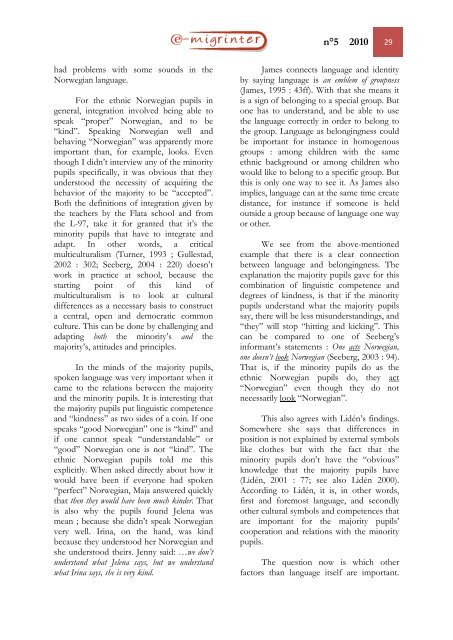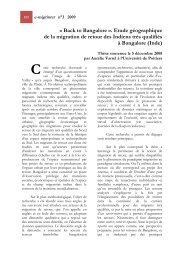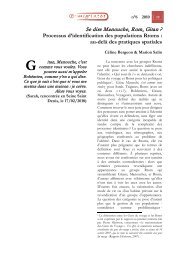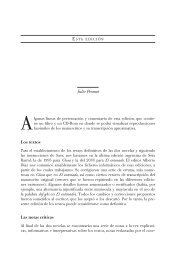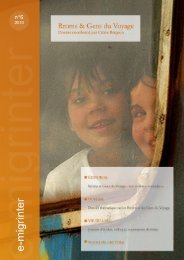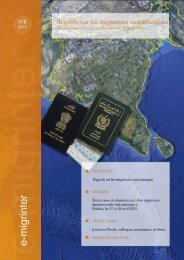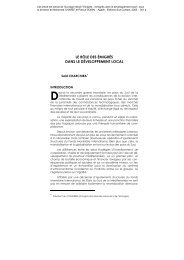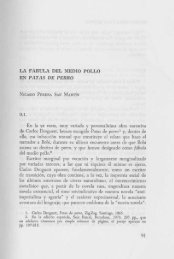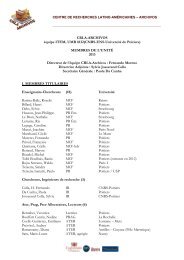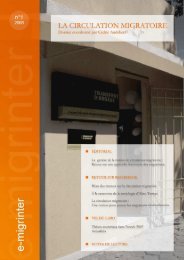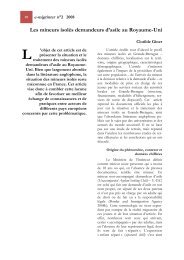e-migrinter 2010 numéro 05 - Maison des Sciences de l'Homme et ...
e-migrinter 2010 numéro 05 - Maison des Sciences de l'Homme et ...
e-migrinter 2010 numéro 05 - Maison des Sciences de l'Homme et ...
Create successful ePaper yourself
Turn your PDF publications into a flip-book with our unique Google optimized e-Paper software.
n°5 <strong>2010</strong> 29<br />
had problems with some sounds in the<br />
Norwegian language.<br />
For the <strong>et</strong>hnic Norwegian pupils in<br />
general, integration involved being able to<br />
speak “proper” Norwegian, and to be<br />
“kind”. Speaking Norwegian well and<br />
behaving “Norwegian” was apparently more<br />
important than, for example, looks. Even<br />
though I didn’t interview any of the minority<br />
pupils specifically, it was obvious that they<br />
un<strong>de</strong>rstood the necessity of acquiring the<br />
behavior of the majority to be “accepted”.<br />
Both the <strong>de</strong>finitions of integration given by<br />
the teachers by the Flata school and from<br />
the L-97, take it for granted that it’s the<br />
minority pupils that have to integrate and<br />
adapt. In other words, a critical<br />
multiculturalism (Turner, 1993 ; Gullestad,<br />
2002 : 302; Seeberg, 2004 : 220) doesn’t<br />
work in practice at school, because the<br />
starting point of this kind of<br />
multiculturalism is to look at cultural<br />
differences as a necessary basis to construct<br />
a central, open and <strong>de</strong>mocratic common<br />
culture. This can be done by challenging and<br />
adapting both the minority’s and the<br />
majority’s, attitu<strong><strong>de</strong>s</strong> and principles.<br />
In the minds of the majority pupils,<br />
spoken language was very important when it<br />
came to the relations b<strong>et</strong>ween the majority<br />
and the minority pupils. It is interesting that<br />
the majority pupils put linguistic comp<strong>et</strong>ence<br />
and “kindness” as two si<strong><strong>de</strong>s</strong> of a coin. If one<br />
speaks “good Norwegian” one is “kind” and<br />
if one cannot speak “un<strong>de</strong>rstandable” or<br />
“good” Norwegian one is not “kind”. The<br />
<strong>et</strong>hnic Norwegian pupils told me this<br />
explicitly. When asked directly about how it<br />
would have been if everyone had spoken<br />
“perfect” Norwegian, Maja answered quickly<br />
that then they would have been much kin<strong>de</strong>r. That<br />
is also why the pupils found Jelena was<br />
mean ; because she didn’t speak Norwegian<br />
very well. Irina, on the hand, was kind<br />
because they un<strong>de</strong>rstood her Norwegian and<br />
she un<strong>de</strong>rstood theirs. Jenny said: …we don’t<br />
un<strong>de</strong>rstand what Jelena says, but we un<strong>de</strong>rstand<br />
what Irina says, she is very kind.<br />
James connects language and i<strong>de</strong>ntity<br />
by saying language is an emblem of groupness<br />
(James, 1995 : 43ff). With that she means it<br />
is a sign of belonging to a special group. But<br />
one has to un<strong>de</strong>rstand, and be able to use<br />
the language correctly in or<strong>de</strong>r to belong to<br />
the group. Language as belongingness could<br />
be important for instance in homogenous<br />
groups : among children with the same<br />
<strong>et</strong>hnic background or among children who<br />
would like to belong to a specific group. But<br />
this is only one way to see it. As James also<br />
implies, language can at the same time create<br />
distance, for instance if someone is held<br />
outsi<strong>de</strong> a group because of language one way<br />
or other.<br />
We see from the above-mentioned<br />
example that there is a clear connection<br />
b<strong>et</strong>ween language and belongingness. The<br />
explanation the majority pupils gave for this<br />
combination of linguistic comp<strong>et</strong>ence and<br />
<strong>de</strong>grees of kindness, is that if the minority<br />
pupils un<strong>de</strong>rstand what the majority pupils<br />
say, there will be less misun<strong>de</strong>rstandings, and<br />
“they” will stop “hitting and kicking”. This<br />
can be compared to one of Seeberg’s<br />
informant’s statements : One acts Norwegian,<br />
one doesn’t look Norwegian (Seeberg, 2003 : 94).<br />
That is, if the minority pupils do as the<br />
<strong>et</strong>hnic Norwegian pupils do, they act<br />
“Norwegian” even though they do not<br />
necessarily look “Norwegian”.<br />
This also agrees with Lidén’s findings.<br />
Somewhere she says that differences in<br />
position is not explained by external symbols<br />
like clothes but with the fact that the<br />
minority pupils don’t have the “obvious”<br />
knowledge that the majority pupils have<br />
(Lidén, 2001 : 77; see also Lidén 2000).<br />
According to Lidén, it is, in other words,<br />
first and foremost language, and secondly<br />
other cultural symbols and comp<strong>et</strong>ences that<br />
are important for the majority pupils’<br />
cooperation and relations with the minority<br />
pupils.<br />
The question now is which other<br />
factors than language itself are important.


